coolant level Seat Exeo ST 2009 Owner's manual
[x] Cancel search | Manufacturer: SEAT, Model Year: 2009, Model line: Exeo ST, Model: Seat Exeo ST 2009Pages: 316, PDF Size: 8.83 MB
Page 62 of 316

Cockpit
60
− Driver information system . . . . . . . . . . . . . . . . . . . . . . . . . . .
CHECK button . . . . . . . . . . . . . . . . . . . . . . . . . . . . . . . . . . . . . . .
Call-up button for service indicator . . . . . . . . . . . . . . . . . . . . . .
Reset button for trip recorder . . . . . . . . . . . . . . . . . . . . . . . . . . .
Coolant temperature gaugeThe coolant temperature gauge ⇒ fig. 38 only works when the ignition is
switched on. In order to avoid engine damage, please read the following
notes for the different temperature ranges.
Cold temperature
If the needle is still on the left of the dial, this indicates that the engine has
not yet reached operating temperature. Avoid high revs and heavy accelera-
tion and do not make the engine work hard. Normal temperature
In normal operations, the needle will settle somewhere in the centre of the
dial once the engine has reached running temperature. The temperature may
also rise when the engine is working hard, especially at high outside temper-
atures. This is no cause for concern, provided the warning lamp
does not
light up in the instrument panel.
Warning temperature
If the symbol
flashes in the display, this means that either the coolant
temperature is too high or the coolant level is too low ⇒page 78.
WARNING
•Before opening the bonnet and checking the coolant level, observe the
warning information ⇒page 227.•Never open the bonnet when steam or coolant is being released from it.
This could lead to burns. Wait until you can no longer see or hear escaping
steam or coolant.Caution
Accessories in front of the air inlet reduce the cooling effect of the coolant. At
high outside temperatures and high e ngine loads, there is a risk of the
engine overheating.
71
A8
64
A9
74
A10
63
Fig. 38 Engine coolant
temperature gauge
AA
ABAC
ExeoST_EN.book Seite 60 Donnerstag, 3. September 2009 12:24 12
Page 79 of 316

Cockpit77
Safety First
Controls and equipment
Practical tips
Technical Data
Red symbols
A red symbol warns of a danger.–Stop the vehicle.
– Switch the engine off.
– Check the fault. Obtain professional assistance if necessary.
The red symbols are used to indicate a Priority 1 fault (serious malfunction).
A red symbol is accompanied by three warning chimes. The symbols will keep
flashing until the faults are corrected. If several Priority 1 faults are detected
at the same time, the symbols are displayed one after the other for about 2
seconds.Fault in the brake system
A fault in the brake system should be rectified as soon as
possible.If the symbol
flashes in the display, there is a fault in the brake
system. One of the following messages will appear in the display
together with the symbol:
Stop vehicle, check brake fluid and hydraulic fluid levels
Warning! Fault in brake system (ABS) Please visit garage
–Stop the vehicle.
– Check the brake fluid level ⇒page 237.
If the ABS fails, the ABS warning lamp
will light up together with the brake
system fault symbol
⇒ .
WARNING
•Before opening the bonnet and checking the brake fluid level, observe
the warning information in ⇒ page 227, “Work in the engine compart-
ment”.•If the brake fluid level in the reservoir is too low, this could result in an
accident. Do not drive on. Obtain technical assistance.
BRAKE
Fault in brake system
⇒ page 77
COOLANT
Coolant level too low / coolant tem-
perature too high
⇒ page 78
OIL
PRESSURE
Engine oil pressure too low
⇒ page 78Fig. 54 Display: Coolant
level warning
ExeoST_EN.book Seite 77 Donnerstag, 3. September 2009 12:24 12
Page 80 of 316

Cockpit
78•If the brake warning lamp lights up together with the ABS warning
lamp, this can mean that the control function of the ABS is out of action. As
a result, the rear wheels can lock relatively easily when braking. Under
certain circumstances, the rear of the vehicle could suddenly sway from
side to side, with the subsequent dang er of skidding. Drive carefully to the
nearest specialist garage and have the fault rectified.
Fault in the cooling system
Faults in the cooling system must be rectified immediately.If the
symbol flashes in the display, this means that either the
coolant temperature is too high or the coolant level is too low. The
following message will appear in the display together with the
symbol:
Switch off engine and check coolant level
– Stop the vehicle.
– Switch the engine off.
– Check the coolant level ⇒page 232.
– Add more coolant if necessary ⇒page 233.
– Wait for the symbol to go out before driving on.
– Obtain professional assistance if necessary.
If the coolant level is correct, the overheating may be caused by a malfunction
of the radiator fan. If the alternator warning lamp lights up as well
⇒page 69, it is possible that
the drive belt has broken.
Caution
Do not drive on if the symbol
has come on to indicate a fault in the cooling
system, otherwise there is a risk of engine damage.
Engine oil pressure too low
If the engine oil pressure is too low the fault must be rectified
immediately.If the
symbol flashes in the display, the oil pressure is too low.
The following message will appear in the display together with the
symbol:
Switch off engine, check oil level
– Stop the vehicle.
– Switch the engine off.
– Check the engine oil level ⇒page 230.
– Obtain professional assistance if necessary.
Engine oil level too low
If the engine oil level is too low, add more oil ⇒page 230.
Engine oil level correct
If the
symbol flashes and the engine oil level is correct, obtain profes-
sional assistance. Do not drive on. Do not continue to run the engine, even at
idle speed .
WARNING (continued)
ExeoST_EN.book Seite 78 Donnerstag, 3. September 2009 12:24 12
Page 162 of 316
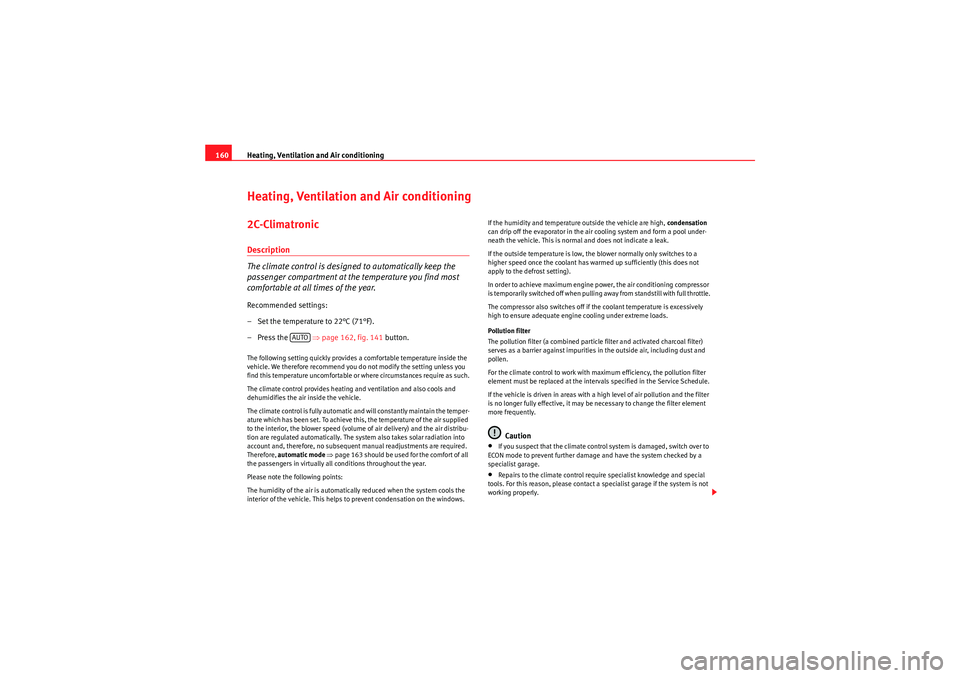
Heating, Ventilation and Air conditioning
160Heating, Ventilation and Air conditioning2C-ClimatronicDescription
The climate control is designed to automatically keep the
passenger compartment at the temperature you find most
comfortable at all times of the year.Recommended settings:
– Set the temperature to 22°C (71°F).
–Press the ⇒page 162, fig. 141 button.The following setting quickly provides a comfortable temperature inside the
vehicle. We therefore recommend you do not modify the setting unless you
find this temperature uncomfortable or where circumstances require as such.
The climate control provides heating and ventilation and also cools and
dehumidifies the air inside the vehicle.
The climate control is fully automatic and will constantly maintain the temper-
ature which has been set. To achieve this, the temperature of the air supplied
to the interior, the blower speed (volume of air delivery) and the air distribu-
tion are regulated automatically. The system also takes solar radiation into
account and, therefore, no subsequent manual readjustments are required.
Therefore, automatic mode ⇒ page 163 should be used for the comfort of all
the passengers in virtually all conditions throughout the year.
Please note the following points:
The humidity of the air is automatically reduced when the system cools the
interior of the vehicle. This helps to prevent condensation on the windows. If the humidity and temperature outside the vehicle are high,
condensation
can drip off the evaporator in the air cooling system and form a pool under-
neath the vehicle. This is normal and does not indicate a leak.
If the outside temperature is low, the blower normally only switches to a
higher speed once the coolant has warmed up sufficiently (this does not
apply to the defrost setting).
In order to achieve maximum engine power, the air conditioning compressor
is tem po ra r ily s witche d o ff whe n pulli ng away f ro m s tan dstill wit h full th rot tle.
The compressor also switches off if the coolant temperature is excessively
high to ensure adequate engine cooling under extreme loads.
Pollution filter
The pollution filter (a combined particle filter and activated charcoal filter)
serves as a barrier against impurities in the outside air, including dust and
pollen.
For the climate control to work with maximum efficiency, the pollution filter
element must be replaced at the intervals specified in the Service Schedule.
If the vehicle is driven in areas with a high level of air pollution and the filter
is no longer fully effective, it may be necessary to change the filter element
more frequently.
Caution
•If you suspect that the climate control system is damaged, switch over to
ECON mode to prevent further damage and have the system checked by a
specialist garage.•Repairs to the climate control require specialist knowledge and special
tools. For this reason, please contact a specialist garage if the system is not
working properly.
AUTO
ExeoST_EN.book Seite 160 Donnerstag, 3. September 2009 12:24 12
Page 229 of 316
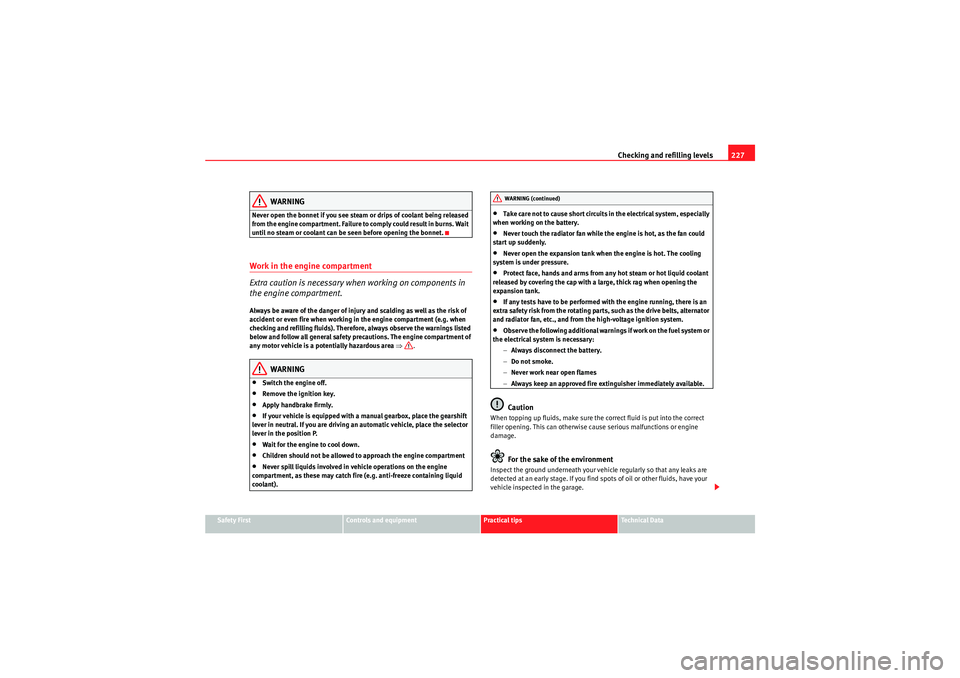
Checking and refilling levels227
Safety First
Controls and equipment
Practical tips
Technical Data
WARNING
Never open the bonnet if you see steam or drips of coolant being released
from t he engine com par t ment . Fail ure to com ply could resul t in burns . Wait
until no steam or coolant can be seen before opening the bonnet.Work in the engine compartment
Extra caution is necessary when working on components in
the engine compartment.Always be aware of the danger of injury and scalding as well as the risk of
accident or even fire when working in the engine compartment (e.g. when
checking and refilling fluids). Therefore, always observe the warnings listed
below and follow all general safety precautions. The engine compartment of
any motor vehicle is a potentially hazardous area ⇒.
WARNING
•Switch the engine off.•Remove the ignition key.•Apply handbrake firmly.•If your vehicle is equipped with a manual gearbox, place the gearshift
lever in neutral. If you are driving an automatic vehicle, place the selector
lever in the position P.•Wait for the engine to cool down.•Children should not be allowed to approach the engine compartment•Never spill liquids involved in vehicle operations on the engine
compartment, as these may catch fire (e.g. anti-freeze containing liquid
coolant).
•Take care not to cause short circuits in the electrical system, especially
when working on the battery.•Never touch the radiator fan while the engine is hot, as the fan could
start up suddenly.•Never open the expansion tank when the engine is hot. The cooling
system is under pressure.•Protect face, hands and arms from any hot steam or hot liquid coolant
released by covering the cap with a large, thick rag when opening the
expansion tank.•If any tests have to be performed with the engine running, there is an
extra safety risk from the rotating parts, such as the drive belts, alternator
and radiator fan, etc., and from the high-voltage ignition system.•Observe the following additional warnings if work on the fuel system or
the electrical system is necessary:
−Always disconnect the battery.
− Do not smoke.
− Never work near open flames
− Always keep an approved fire extinguisher immediately available.Caution
When topping up fluids, make sure the correct fluid is put into the correct
filler opening. This can otherwise cause serious malfunctions or engine
damage.
For the sake of the environment
Inspect the ground underneath your vehicle regularly so that any leaks are
detected at an early stage. If you find spots of oil or other fluids, have your
vehicle inspected in the garage.
WARNING (continued)
ExeoST_EN.book Seite 227 Donnerstag, 3. September 2009 12:24 12
Page 233 of 316
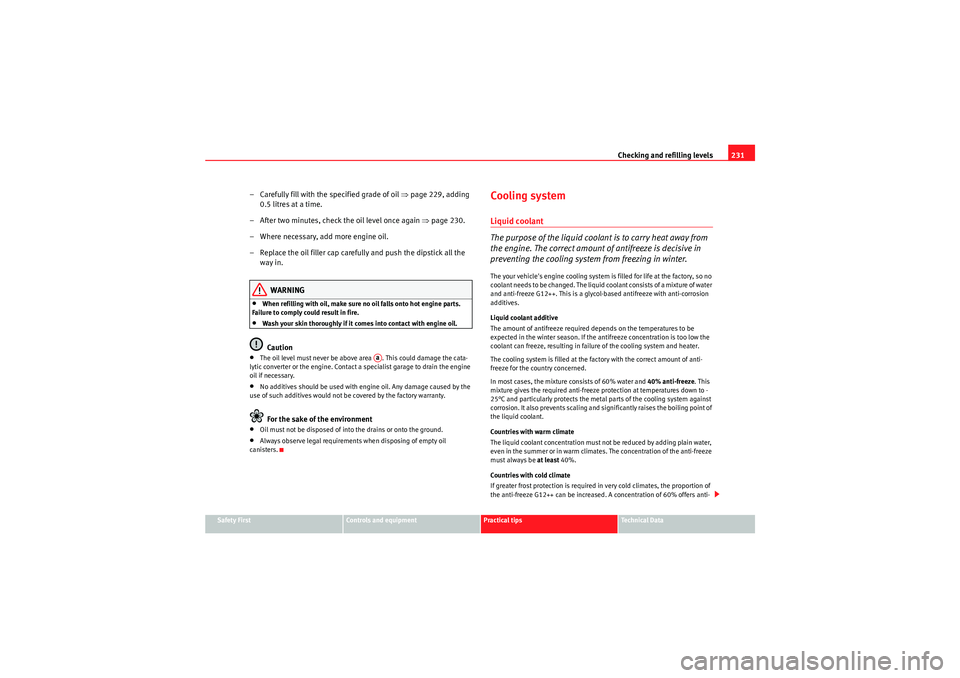
Checking and refilling levels231
Safety First
Controls and equipment
Practical tips
Technical Data
– Carefully fill with the specified grade of oil ⇒page 229, adding
0.5 litres at a time.
– After two minutes, check the oil level once again ⇒page 230.
– Where necessary, add more engine oil.
– Replace the oil filler cap carefully and push the dipstick all the way in.
WARNING
•When refilling with oil, make sure no oil falls onto hot engine parts.
Failure to comply could result in fire.•Wash your skin thoroughly if it comes into contact with engine oil.Caution
•The oil level must never be above area . This could damage the cata-
lytic converter or the engine. Contact a specialist garage to drain the engine
oil if necessary.•No additives should be used with engine oil. Any damage caused by the
use of such additives would not be covered by the factory warranty.For the sake of the environment
•Oil must not be disposed of into the drains or onto the ground.•Always observe legal requirements when disposing of empty oil
canisters.
Cooling systemLiquid coolant
The purpose of the liquid coolant is to carry heat away from
the engine. The correct amount of antifreeze is decisive in
preventing the cooling system from freezing in winter.The your vehicle's engine cooling system is filled for life at the factory, so no
coolant needs to be changed. The liquid coolant consists of a mixture of water
and anti-freeze G12++. This is a glycol-based antifreeze with anti-corrosion
additives.
Liquid coolant additive
The amount of antifreeze required depends on the temperatures to be
expected in the winter season. If the antifreeze concentration is too low the
coolant can freeze, resulting in failure of the cooling system and heater.
The cooling system is filled at the factory with the correct amount of anti-
freeze for the country concerned.
In most cases, the mixture consists of 60% water and 40% anti-freeze . This
mixture gives the required anti-freeze protection at temperatures down to -
25°C and particularly protects the metal parts of the cooling system against
corrosion. It also prevents scaling and significantly raises the boiling point of
the liquid coolant.
Countries with warm climate
The liquid coolant concentration must not be reduced by adding plain water,
even in the summer or in warm climates. The concentration of the anti-freeze
must always be at least 40%.
Countries with cold climate
If greater frost protection is required in very cold climates, the proportion of
the anti-freeze G12++ can be increased. A concentration of 60% offers anti-
Aa
ExeoST_EN.book Seite 231 Donnerstag, 3. September 2009 12:24 12
Page 234 of 316
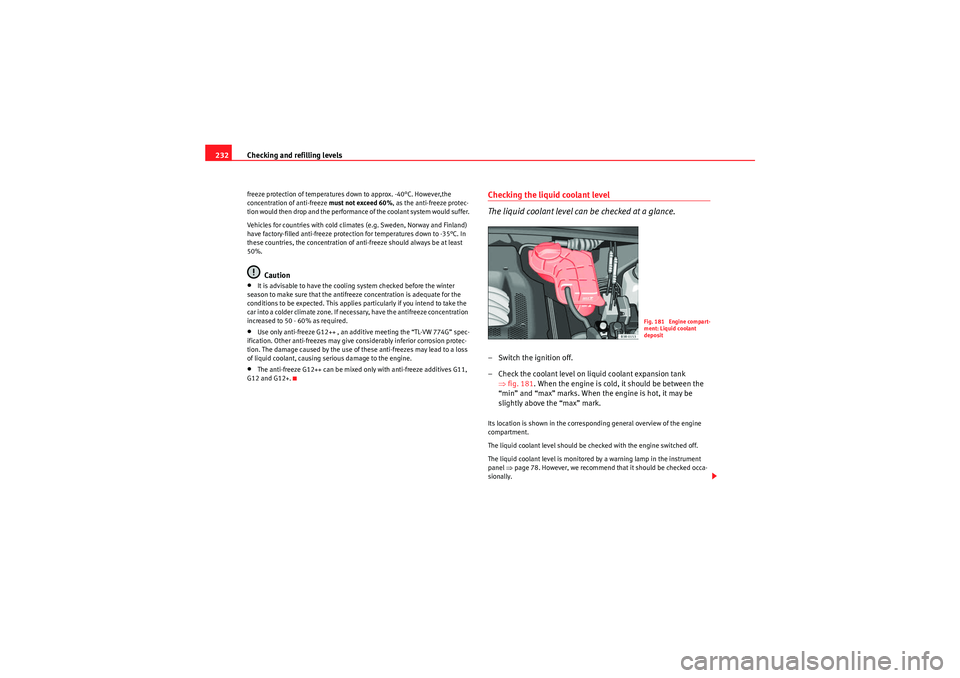
Checking and refilling levels
232freeze protection of temperatures down to approx. -40°C. However,the
concentration of anti-freeze must not exceed 60%, as the anti-freeze protec-
tion would then drop and the performance of the coolant system would suffer.
Vehicles for countries with cold climates (e.g. Sweden, Norway and Finland)
have factory-filled anti-freeze protection for temperatures down to -35°C. In
these countries, the concentration of anti-freeze should always be at least
50%.
Caution
•It is advisable to have the cooling system checked before the winter
season to make sure that the antifreeze concentration is adequate for the
conditions to be expected. This applies particularly if you intend to take the
car into a colder climate zone. If necessary, have the antifreeze concentration
increased to 50 - 60% as required.•Use only anti-freeze G12++ , an additive meeting the “TL-VW 774G” spec-
ification. Other anti-freezes may give considerably inferior corrosion protec-
tion. The damage caused by the use of these anti-freezes may lead to a loss
of liquid coolant, causing serious damage to the engine.•The anti-freeze G12++ can be mixed only with anti-freeze additives G11,
G12 and G12+.
Checking the liquid coolant level
The liquid coolant level can be checked at a glance.– Switch the ignition off.
– Check the coolant level on liquid coolant expansion tank ⇒fig. 181 . When the engine is cold, it should be between the
“min” and “max” marks. When the engine is hot, it may be
slightly above the “max” mark.Its location is shown in the corresponding general overview of the engine
compartment.
The liquid coolant level should be checked with the engine switched off.
The liquid coolant level is monitored by a warning lamp in the instrument
panel ⇒ page 78. However, we recommend that it should be checked occa-
sionally.
Fig. 181 Engine compart-
ment: Liquid coolant
deposit
ExeoST_EN.book Seite 232 Donnerstag, 3. September 2009 12:24 12
Page 235 of 316
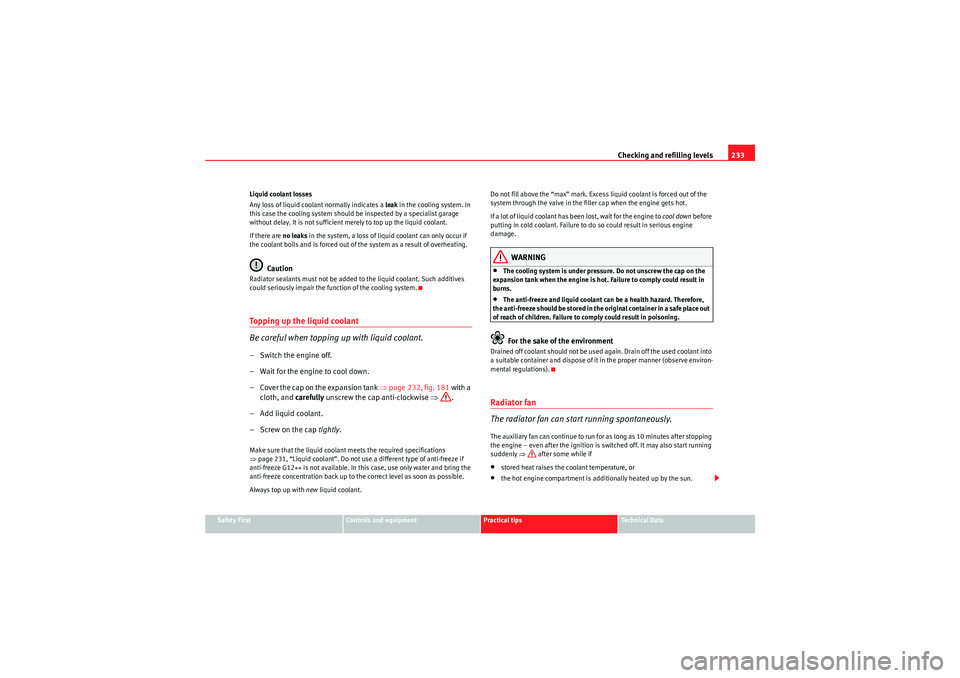
Checking and refilling levels233
Safety First
Controls and equipment
Practical tips
Technical Data
Liquid coolant losses
Any loss of liquid coolant normally indicates a
leak in the cooling system. In
this case the cooling system should be inspected by a specialist garage
without delay. It is not sufficient merely to top up the liquid coolant.
If there are no leaks in the system, a loss of liquid coolant can only occur if
the coolant boils and is forced out of the system as a result of overheating.
Caution
Radiator sealants must not be added to the liquid coolant. Such additives
could seriously impair the function of the cooling system.Topping up the liquid coolant
Be careful when topping up with liquid coolant.– Switch the engine off.
– Wait for the engine to cool down.
– Cover the cap on the expansion tank ⇒page 232, fig. 181 with a
cloth, and carefully unscrew the cap anti-clockwise ⇒.
– Add liquid coolant.
– Screw on the cap tightly.Make sure that the liquid coolant meets the required specifications
⇒page 231, “Liquid coolant”. Do not use a different type of anti-freeze if
anti-freeze G12++ is not available. In this case, use only water and bring the
anti-freeze concentration back up to the correct level as soon as possible.
Always top up with new liquid coolant. Do not fill above the “max” mark. Excess liquid coolant is forced out of the
system through the valve in the filler cap when the engine gets hot.
If a lot of liquid coolant has been lost, wait for the engine to
cool down before
putting in cold coolant. Failure to do so could result in serious engine
damage.
WARNING
•The cooling system is under pressure. Do not unscrew the cap on the
expansion tank when the engine is hot. Failure to comply could result in
burns.•The anti-freeze and liquid coolant can be a health hazard. Therefore,
the anti-freeze should be stored in the original container in a safe place out
of reach of children. Failure to comply could result in poisoning.For the sake of the environment
Drained off coolant should not be used again. Drain off the used coolant into
a suitable container and dispose of it in the proper manner (observe environ-
mental regulations).Radiator fan
The radiator fan can start running spontaneously.The auxiliary fan can continue to run for as long as 10 minutes after stopping
the engine – even after the ignition is switched off. It may also start running
suddenly ⇒ after some while if•stored heat raises the coolant temperature, or•the hot engine compartment is additionally heated up by the sun.
ExeoST_EN.book Seite 233 Donnerstag, 3. September 2009 12:24 12
Page 297 of 316
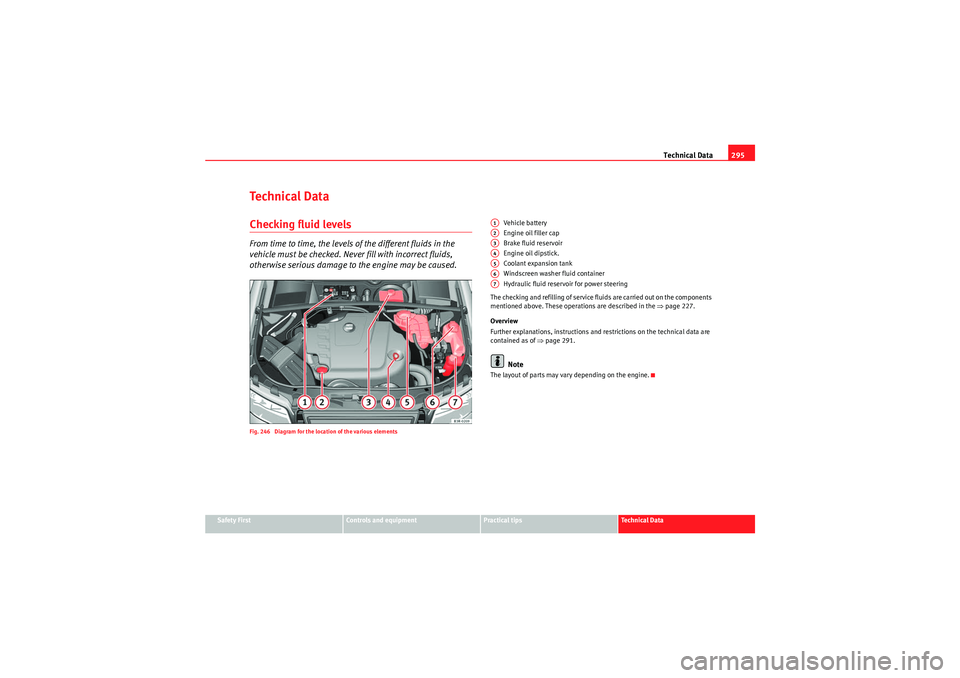
Technical Data295
Safety First
Controls and equipment
Practical tips
Technical Data
Te c h n i c a l D a t aChecking fluid levelsFrom time to time, the levels of the different fluids in the
vehicle must be checked. Never fill with incorrect fluids,
otherwise serious damage to the engine may be caused.Fig. 246 Diagram for the location of the various elements
Vehicle battery
Engine oil filler cap
Brake fluid reservoir
Engine oil dipstick.
Coolant expansion tank
Windscreen washer fluid container
Hydraulic fluid reservoir for power steering
The checking and refilling of service fluids are carried out on the components
mentioned above. These operations are described in the ⇒page 227.
Overview
Further explanations, instructions and restrictions on the technical data are
contained as of ⇒page 291.Note
The layout of parts may vary depending on the engine.A1A2A3A4A5A6A7
ExeoST_EN.book Seite 295 Donnerstag, 3. September 2009 12:24 12
Page 311 of 316
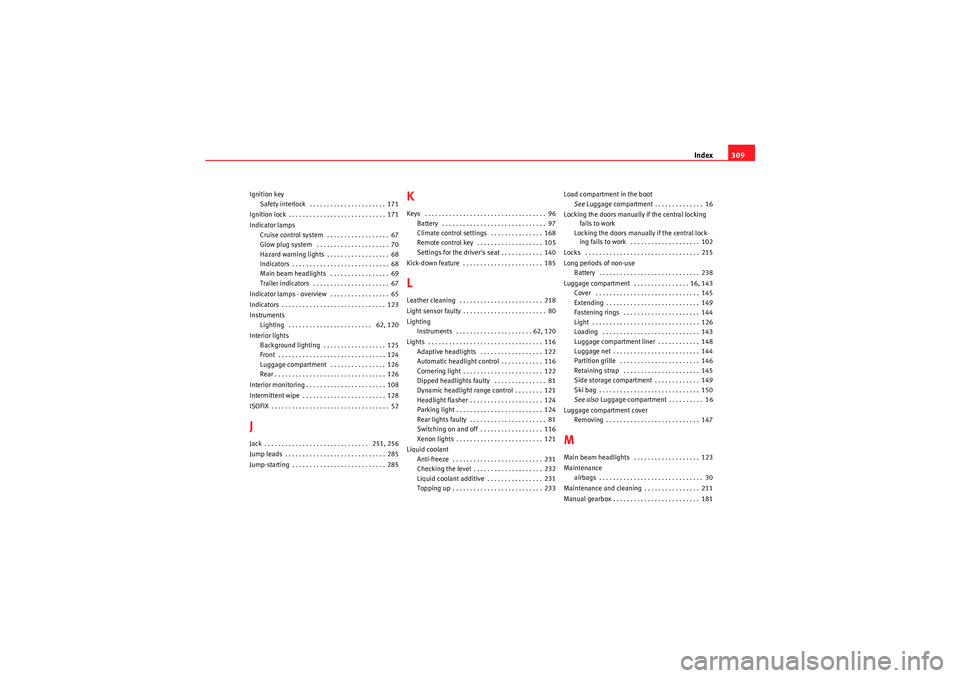
Index309
Ignition key
Safety interlock . . . . . . . . . . . . . . . . . . . . . . 171
Ignition lock . . . . . . . . . . . . . . . . . . . . . . . . . . . . 171
Indicator lamps Cruise control system . . . . . . . . . . . . . . . . . . 67
Glow plug system . . . . . . . . . . . . . . . . . . . . . 70
Hazard warning lights . . . . . . . . . . . . . . . . . . 68
Indicators . . . . . . . . . . . . . . . . . . . . . . . . . . . . 68
Main beam headlights . . . . . . . . . . . . . . . . . 69
Trailer indicators . . . . . . . . . . . . . . . . . . . . . . 67
Indicator lamps - overview . . . . . . . . . . . . . . . . . 65
Indicators . . . . . . . . . . . . . . . . . . . . . . . . . . . . . . 123
Instruments Lighting . . . . . . . . . . . . . . . . . . . . . . . . 62, 120
Interior lights Background lighting . . . . . . . . . . . . . . . . . . 125
Front . . . . . . . . . . . . . . . . . . . . . . . . . . . . . . . 124
Luggage compartment . . . . . . . . . . . . . . . . 126
Rear . . . . . . . . . . . . . . . . . . . . . . . . . . . . . . . . 126
Interior monitoring . . . . . . . . . . . . . . . . . . . . . . . 108
Intermittent wipe . . . . . . . . . . . . . . . . . . . . . . . . 128
ISOFIX . . . . . . . . . . . . . . . . . . . . . . . . . . . . . . . . . . 52JJack . . . . . . . . . . . . . . . . . . . . . . . . . . . . . . 251, 256
Jump leads . . . . . . . . . . . . . . . . . . . . . . . . . . . . . 285
Jump-starting . . . . . . . . . . . . . . . . . . . . . . . . . . . 285
KKeys . . . . . . . . . . . . . . . . . . . . . . . . . . . . . . . . . . . 96 Battery . . . . . . . . . . . . . . . . . . . . . . . . . . . . . . 97
Climate control settings . . . . . . . . . . . . . . . 168
Remote control key . . . . . . . . . . . . . . . . . . . 105
Settings for the driver's seat . . . . . . . . . . . . 140
Kick-down feature . . . . . . . . . . . . . . . . . . . . . . . 185LLeather cleaning . . . . . . . . . . . . . . . . . . . . . . . . 218
Light sensor faulty . . . . . . . . . . . . . . . . . . . . . . . . 80
Lighting Instruments . . . . . . . . . . . . . . . . . . . . . . 62, 120
Lights . . . . . . . . . . . . . . . . . . . . . . . . . . . . . . . . . 116 Adaptive headlights . . . . . . . . . . . . . . . . . . 122
Automatic headlight control . . . . . . . . . . . . 116
Cornering light . . . . . . . . . . . . . . . . . . . . . . . 122
Dipped headlights faulty . . . . . . . . . . . . . . . 81
Dynamic headlight range control . . . . . . . . 121
Headlight flasher . . . . . . . . . . . . . . . . . . . . . 124
Parking light . . . . . . . . . . . . . . . . . . . . . . . . . 124
Rear lights faulty . . . . . . . . . . . . . . . . . . . . . . 81
Switching on and off . . . . . . . . . . . . . . . . . . 116
Xenon lights . . . . . . . . . . . . . . . . . . . . . . . . . 121
Liquid coolant Anti-freeze . . . . . . . . . . . . . . . . . . . . . . . . . . 231
Checking the level . . . . . . . . . . . . . . . . . . . . 232
Liquid coolant additive . . . . . . . . . . . . . . . . 231
Topping up . . . . . . . . . . . . . . . . . . . . . . . . . . 233 Load compartment in the boot
See Luggage compartment . . . . . . . . . . . . . . 16
Locking the doors manually if the central locking fails to work
Locking the doors manually if the central lock- ing fails to work . . . . . . . . . . . . . . . . . . . . 102
Locks . . . . . . . . . . . . . . . . . . . . . . . . . . . . . . . . . 215
Long periods of non-use Battery . . . . . . . . . . . . . . . . . . . . . . . . . . . . . 238
Luggage compartment . . . . . . . . . . . . . . . . 16, 143 Cover . . . . . . . . . . . . . . . . . . . . . . . . . . . . . . 145
Extending . . . . . . . . . . . . . . . . . . . . . . . . . . . 149
Fastening rings . . . . . . . . . . . . . . . . . . . . . . 144
Light . . . . . . . . . . . . . . . . . . . . . . . . . . . . . . . 126
Loading . . . . . . . . . . . . . . . . . . . . . . . . . . . . 143
Luggage compartment liner . . . . . . . . . . . . 148
Luggage net . . . . . . . . . . . . . . . . . . . . . . . . . 144
Partition grille . . . . . . . . . . . . . . . . . . . . . . . 146
Retaining strap . . . . . . . . . . . . . . . . . . . . . . 145
Side storage compartment . . . . . . . . . . . . . 149
Ski bag . . . . . . . . . . . . . . . . . . . . . . . . . . . . . 150
See also Luggage compartment . . . . . . . . . . 16
Luggage compartment cover Removing . . . . . . . . . . . . . . . . . . . . . . . . . . . 147
MMain beam headlights . . . . . . . . . . . . . . . . . . . 123
Maintenanceairbags . . . . . . . . . . . . . . . . . . . . . . . . . . . . . . 30
Maintenance and cleaning . . . . . . . . . . . . . . . . 211
Manual gearbox . . . . . . . . . . . . . . . . . . . . . . . . . 181
ExeoST_EN.book Seite 309 Donnerstag, 3. September 2009 12:24 12